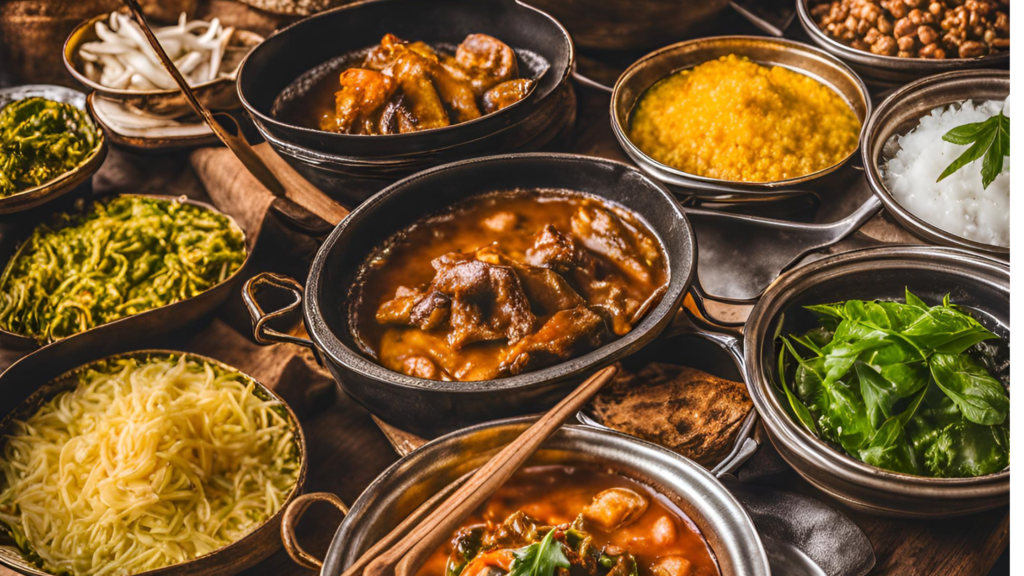Savor the World: A Journey Through Culture and Cuisine
The Transformative Power of Cultural Immersion Through Food
Every culture possesses a vibrant heartbeat, and this rhythm is often felt most strongly in its kitchens and markets. Food, as a fundamental aspect of human existence, extends far beyond mere sustenance; it transforms into a rich tapestry woven with stories told through spices, textures, and aromas. As travelers, immersing ourselves in local cuisine bridges the gap between visitor and native, allowing us to connect deeply with the essence of a place. It’s through our palates that we can explore the narratives of culture, tradition, and community.
Researching Food Traditions Before Your Trip
Before embarking on your culinary journey, it pays to delve into the food traditions of your destination. Research staple dishes, their historical significance, and their role in daily life. This knowledge doesn’t just enhance your dining experience; it allows you to appreciate the deeper meaning behind each dish, transforming every meal into an opportunity for cultural engagement.
For instance, in Thailand, understanding the balance of flavors—sweet, sour, salty, and spicy—and how these elements create harmony in a traditional dish like Pad Thai can deepen your appreciation. Similarly, knowing that Italy’s risotto originates from the northern regions’ rice-farming communities enhances your respect for this creamy, flavorful dish.
To embark on this research, utilize travel books, documentaries, blogs, and vlogs that focus on the culinary aspects of your chosen destination. Social media platforms can also provide insight, with food content creators and local chefs sharing their expertise and experiences.
Understanding Dietary Customs and Etiquette
Food customs and dining etiquette are integral to experiencing a culture fully. In Japan, slurping noodles is not only acceptable but is considered a genuine compliment to the chef, while in Italy, asking for ketchup for your pasta might elicit disapproving glances. Understanding these customs enriches your experience, making you feel more connected to the local people.
Moreover, be aware of dietary restrictions or customs that may exist in certain cultures. In many Middle Eastern countries, sharing food is a sign of hospitality, and being respectful in how you accept and consume food can open doors to deeper interactions.
Researching local customs, potentially with the assistance of platforms like “Culture Trip,” can offer invaluable insights into what to expect and how to behave at the dining table.
The Historical Roots of Regional Cuisines
Culinary traditions are influenced by a region’s history, migration patterns, and trade routes. Every dish can tell a tale rich with the complexities of human experience. The spices of India, for example, whisper stories of ancient trade routes, while French pâtisserie reflects centuries of culinary artistry.
Consider the origins of dishes like Moroccan tagine, which showcases a blend of North African flavors influenced by Berber, Arabic, and Mediterranean cultures. The techniques and ingredients used in local cuisine are often historical artifacts, encapsulating centuries of lifestyle.
Explore local cookbooks, take guided food history tours, or visit museums dedicated to culinary traditions. Engaging with locals who are passionate about their food history can also provide insights that enrich your understanding of the cuisine.
Exploring Vibrant Local Markets
Markets serve as the lifeblood of any community, brimming with colors, aromas, and sounds that paint a vibrant picture of local life. From the bustling souks of Morocco to the floating markets of Thailand, these spaces offer a feast for the senses and provide a unique opportunity to experience local culture.
Wandering through local markets allows you to see the ingredients that make up the cuisine you’ll later enjoy. You can observe the farms’ bounty, from fresh vegetables to artisanal cheeses, and appreciate how these elements come together to form beloved dishes.
Interacting with Vendors to Learn About Regional Specialties
One of the most enriching aspects of exploring local markets is the opportunity to engage with vendors. They are often living repositories of culinary wisdom, eager to share their knowledge about the spices, cheeses, and produce they sell. Don’t hesitate to ask questions about how to use certain ingredients, seek their recommendations, or request recipes.
For example, while in a spice market in Istanbul, inquire about the uses of saffron and sumac, and learn about the regional dishes they accompany. This interaction not only enhances your culinary knowledge but also establishes a connection with the local community.
Sampling Street Food as a Window Into DailyLife
Street food is often regarded as the heart of a city’s culinary scene, where authenticity thrives. Whether it’s tacos from a roadside cart in Mexico or banh mi in Vietnam, these humble meals often deliver some of the richest flavors you’ll ever experience. Street food encapsulates the concept of culinary democracy, showcasing local ingredients, culinary traditions, and innovative practices in a compact form.
To immerse yourself in the local food scene, explore bustling streets filled with food stalls and vendors. Don’t be afraid to be adventurous—trying the specialties of the locals can lead to delightful surprises. For instance, take a journey through the street food scene of Bangkok, where you can savor flavorful dishes such as som tam (spicy green papaya salad), moo pad krapow (stir-fried basil pork), or mango sticky rice—all available from street carts that draw long lines of locals.
Hygiene Tips for a Safe Experience
While street food offers a delectable glimpse into daily life, it’s essential to prioritize your health and safety. To enjoy street food safely, follow these hygiene tips:
- Look for Popular Stalls: A long line of local patrons typically signifies a trustworthy vendor. Locals often know where to find the best and safest food.
- Observe Food Preparation: Check the cleanliness of the stall and the hygiene practices of the vendors. Look for freshly prepared dishes instead of those sitting out for long periods.
- Use Hand Sanitizer: Carry hand sanitizer to ensure your hands are clean before eating, especially if utensils and plates are not provided.
- Stick to Cooked Foods: Opt for dishes that have been thoroughly cooked and served hot, steering clear of raw items where possible, especially in warmer climates.
The Charm of Dining With Locals
One of the most memorable ways to engage with a culture is to share a meal in a local’s home. Platforms like Eatwith or BonAppetour connect travelers with hosts eager to share their culinary traditions. Dining with locals allows for meaningful discussions about their food, traditions, and lifestyle.
Imagine being welcomed into a traditional family home in Tuscany, where you help prepare fresh pasta and enjoy an authentic meal paired with local wines, all while exchanging stories. These experiences create lasting memories and foster a genuine connection to the culture.
How Climate Shapes Local Ingredients
The terroir of a region significantly influences its cuisine. Rich in biodiversity, certain regions produce unique ingredients that define their culinary identity. The lush hills of Tuscany yield robust wines and exquisite olive oil, while the arid landscapes of Morocco inspire lively tagines filled with spices and dried fruits.
Understanding how climate shapes local ingredients enhances your appreciation for regional dishes. Explore local farms or vineyards during your travels to see firsthand how geography affects agriculture. Talk to farmers or local producers to learn about their practices and the seasonal changes that influence what you’ll find on your plate.
The Importance of Seasonality in Traditional Dishes
Seasonality is not merely a trend; it’s a time-honored concept that anchors cuisine. Eating seasonally ensures that you enjoy foods at their peak freshness and flavor while supporting sustainable agricultural practices. For instance, Japan celebrates the arrival of cherry blossoms with seasonal menus featuring sakura-flavored dishes and delicate sweets—a reflection of the fleeting beauty of spring.
By enjoying traditional dishes that honor the season, like hearty stews in winter or fresh salads in summer, you gain insight into local culinary practices and community rhythms.
Participating in Food-Centric Festivals
Food festivals serve as a jubilant celebration of culture and community. Events such as Oktoberfest in Germany, which showcases traditional beers and German cuisine, or the Mooncake Festival in China, which features mooncakes and family gatherings, provide an immersive experience into the culture of a region.
Attending these festivals allows travelers to taste a variety of dishes and learn about the cultural significance behind them, providing a richer understanding of local traditions. These events also create opportunities to interact with locals and other travelers, fostering connections through shared cultural experiences.
Discovering Symbolic Dishes at Celebrations
Many cultural dishes carry symbolic weight, representing various aspects of life and community. For example, in Greece, the tradition of breaking bread at Easter symbolizes community and rebirth. Dumplings in China are believed to symbolize prosperity, especially during the Lunar New Year.
Understanding the significance of these dishes adds another layer of appreciation to your culinary exploration. Gatherings around symbolic foods often have deep familial and cultural ties, providing insight into the values that underpin the community’s social fabric.
Sampling Traditional Drinks and Their Cultural Significance
From Turkish tea ceremonies to Argentinian mate rituals, beverages are often cultural anchors that tell stories about tradition and hospitality. Beverage customs can offer insights into societal norms—like the importance of sharing a cup of tea as a sign of hospitality in many cultures.
Participating in these rituals allows for deeper engagement with the culture. In Morocco, for instance, being invited to a traditional tea ceremony offers a peaceful respite and a moment to connect with locals while savoring the sweet, minty flavors of Moroccan mint tea.
Learning to Cook Local Dishes With Skilled Chefs
Cooking classes provide an invaluable opportunity for hands-on cultural immersion. Engaging with skilled chefs allows travelers to learn not just recipes but also the history and techniques behind each dish. Whether it’s kneading fresh Italian pasta, rolling sushi, or folding the perfect samosa, cooking classes foster connections between travelers and locals.
Programs such as local cooking schools, workshops, or community classes offer participants the chance to not only cook but also enjoy a meal together, often truly reflecting the essence of cultural exchange.
Exploring How Local Flavors Blend With Global Influences
In our increasingly interconnected world, culinary boundaries often blur as cultures converge, resulting in fusion cuisine that tells the story of global interaction. Dishes like sushi burritos or kimchi tacos exemplify how diverse culinary traditions can combine to create something new and exciting.
Exploring fusion cuisine allows travelers to appreciate the versatility of ingredients and techniques drawn from different cultures. Participating in tastings at local restaurants that focus on innovative food pairings can deepen your understanding of how global influences enrich local dishes.
Uncovering the Stories Behind Iconic Desserts
Desserts often have fascinating histories that reflect a region’s culinary evolution. Take the French croissant, for instance, which originated from Austrian kipferl before making its way to France, where it was perfected into the buttery pastry we know today. Turkish delight, deeply rooted in the Ottoman Empire, continues to be cherished in Turkey and around the world, serving as a symbol of hospitality and indulgence.
Learning about the origins of iconic desserts provides deeper insight into cultural traditions as well as the influences that shaped them. Consider taking a dessert-making workshop during your travels, allowing you to appreciate these sweet treats from a historical and practical perspective.
How Sharing Meals Fosters Relationships
Food transcends language barriers, offering a unique way to connect with people from diverse backgrounds. Sharing a meal fosters relationships, turning strangers into friends over conversations, laughter, and shared experiences.
When dining with locals, you open yourself to a world of stories and traditions that bring life to the dishes being served. By participating in communal meals—whether in homes, at street markets, or during festivals—you allow yourself to become a part of the community, experiencing the warmth of human connections that food naturally creates.
The Importance of Ethical Food Choices
In an age where conscious consumerism is on the rise, making ethical food choices while traveling is imperative. Supporting local farmers and restaurants that practice sustainability respects both the culture and the environment.
Seek out establishments that source their ingredients locally, prioritize organic farming practices, and avoid exploitative tourism practices that harm local communities. Understanding the impact of your choices on the environment and social structures not only enhances your journey but also contributes to the preservation of culinary heritage.
Tips for Photographing Food While Traveling
Capturing the essence of your culinary journey is a wonderful way to document your travels. When photographing food, consider the following tips:
- Focus on Natural Lighting: Good lighting enhances food photography. Aim to shoot in natural light, whether you’re dining al fresco or by a window.
- Composition Matters: Frame your dish thoughtfully to highlight its textures and colors. Use props—like utensils, fabrics, or other dishes—to create a more inviting setup.
- Get Creative with Angles: Experiment with different angles to find the most visually appealing representation of your meal. Overhead shots work well for flat dishes, while side angles can showcase layers and textures.
- Tell a Story: Use your food photography to share a story. Include a background element that represents the locale, such as traditional tableware or bustling market scenes, to provide context.
Personal Growth Through Trying New Foods
Culinary travel serves as a platform for personal growth. Trying unfamiliar flavors and dishes builds empathy, adaptability, and an adventurous spirit. Each new taste provides an opportunity to discover aspects of yourself, expanding your palate and cultural understanding.
Traveling with an open mind allows you to embrace the unfamiliar, leading to richer experiences. Whether indulging in spicy Sichuan cuisine for the first time or savoring delicacies found in a bustling bazaar, each experience contributes to your character and worldview.
Final Thoughts on the Profound Impact of Culinary Exploration
Embracing local cuisine is more than just a sensory experience—it’s a gateway to understanding the world. Each dish is a testament to the history, struggles, and triumphs of a community. The stories behind the food connect us as human beings, transcending language and cultural differences.
As you savor each bite, take the time to appreciate the culture, history, and humanity behind it. Culinary exploration allows you to embark on a transformative journey that enriches your travels and deepens your engagement with the world.
In a globalized society where food continues to evolve, remember that every meal holds the power to connect you with the heart and soul of a culture. So, step outside of your comfort zone, discover new flavors, and embrace the culinary landscapes waiting to be explored. Safe travels and happy eating!



